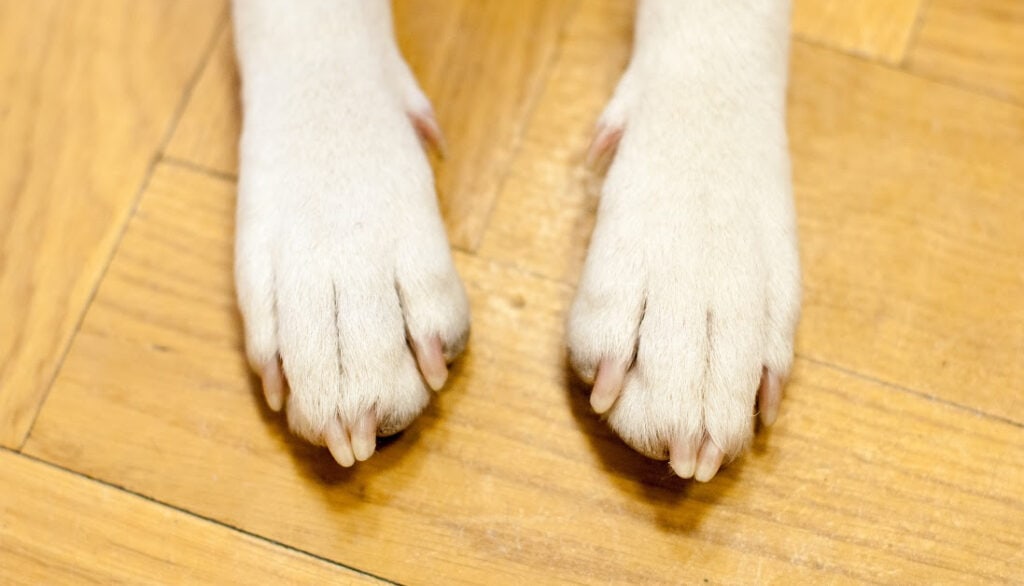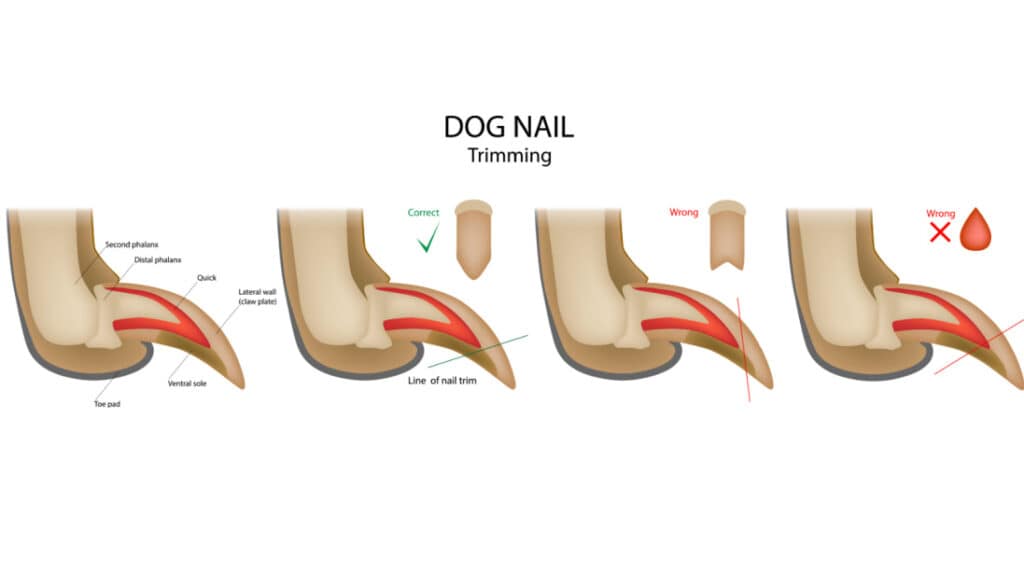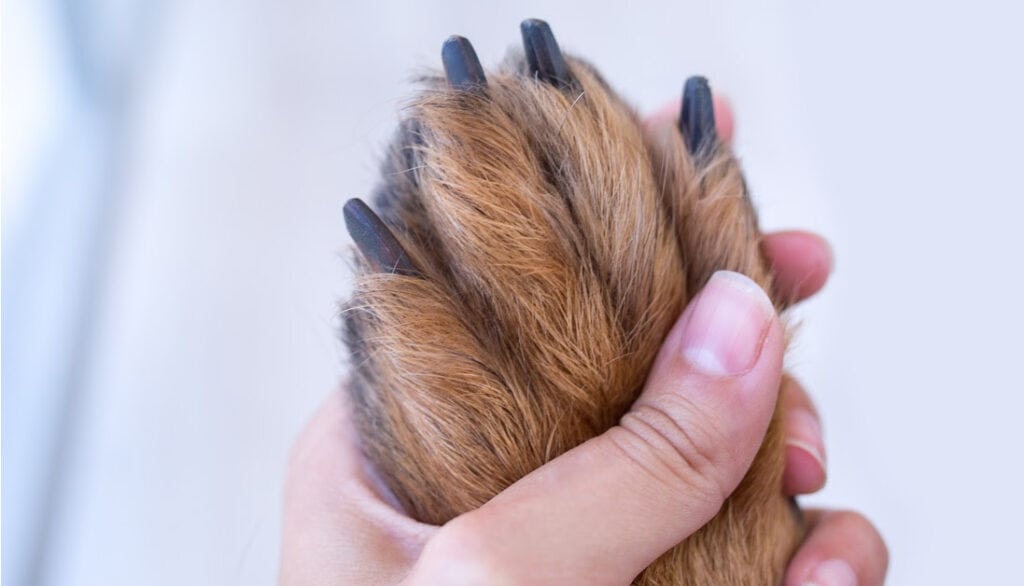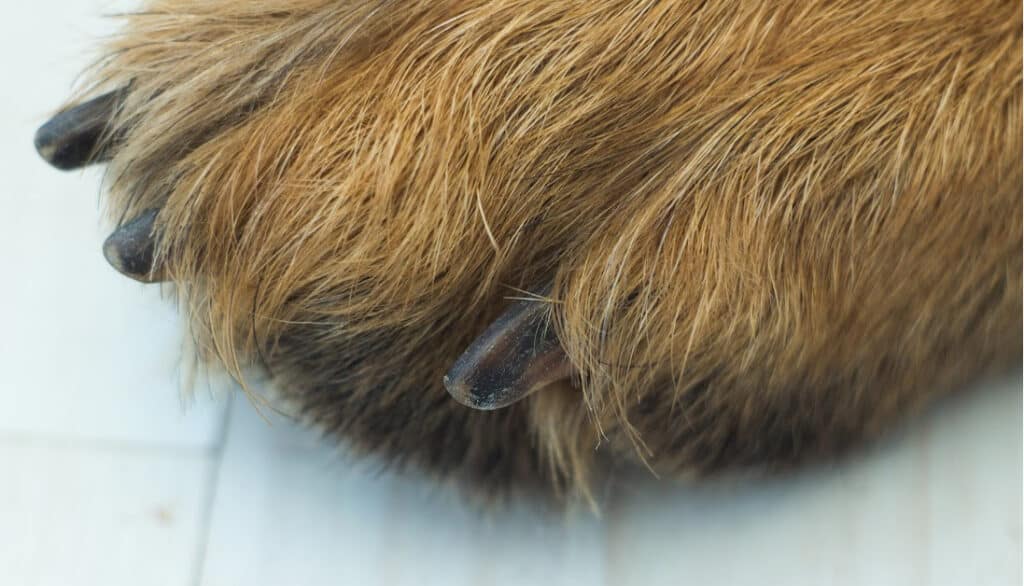Hello fellow dog parents! When it comes to our furry friends, we all strive to ensure they’re in optimal health, and often, that care extends right down to their paws. Ever found yourself wondering, “How long should my dog’s nails be?” or “Am I trimming them correctly?” You’re not alone! Ensuring the right nail length is not just about aesthetics; it’s a crucial aspect of their overall well-being. Too long, and they could face discomfort or even injury; too short, and you might hurt their sensitive quicks. Fear not, in this comprehensive guide, we’ll delve deep into the perfect nail length for your pooch, offering you trim tips that guarantee a happy, healthy dog. Let’s get those paws looking and feeling their best!

How Long Should Dog Nails Be?
First and foremost, understanding the significance of your dog’s nail length is essential.
- Comfort: Just like our nails, if a dog’s nails are too long, they can cause discomfort. Every time they step, the pressure pushes their nails back into their nail beds which can be painful.
- Posture & Gait: Overgrown nails can affect the way a dog walks. They might adjust their posture and gait to avoid the discomfort, which can lead to skeletal issues over time.
- Injury Prevention: Long nails are more prone to getting caught in carpets or other surfaces, which can result in tears or breaks. This is not only painful but can sometimes lead to infections.
So, How Long Should Dog Nails Be?
The ideal length varies depending on the breed and the individual dog, but here are some general guidelines:
- Hearing the ‘Click’: If your dog walks on a hard surface and you hear their nails clicking, it’s usually a sign that they’re too long.
- Ground Touch: When standing, your dog’s nails (especially the front nails) should either just touch the ground or be slightly above it. If the nails are constantly pressing into the ground, it’s trimming time.
- Curve Check: Examine the curve of your dog’s nails. If they’re starting to curl under, they’ve grown too long.
Tips for Maintaining the Right Nail Length
- Regular Trimming: Depending on the growth rate, you may need to trim your dog’s nails every 2-4 weeks. Some breeds might need more frequent trims.
- Invest in Quality Tools: A good pair of dog nail clippers or a dremel can make the task easier and more efficient.
- Check for the Quick: The ‘quick’ is the sensitive part of the nail that has blood vessels. Always be careful not to cut into this. If your dog has clear nails, the quick will appear pink. For dogs with dark nails, you’ll have to trim a little at a time and look for a dark circle in the center of the nail – that’s where the quick starts.
- Stay Calm, Reward Often: Especially if your dog isn’t used to nail trims, ensure you make the experience as positive as possible. Treats, praises, and patience go a long way.
Seek Professional Help if Unsure
If you’re ever in doubt about how to trim your dog’s nails or fear you might hurt them, consult with a professional. Many groomers and veterinarians offer this service and can even provide you with tips tailored to your dog.
To wrap up, maintaining the right nail length for your dog is vital for their comfort and health. With regular checks and trims, you’ll ensure your furry friend stays in tip-top shape from nose to tail—and nails!

How to Find the Quick on Dog Nails
Before diving into how to find the quick, it’s important to understand what it is. The quick is the sensitive part of a dog’s nail that contains blood vessels and nerves. Accidentally cutting into the quick can cause pain and bleeding, making it crucial to identify its location during nail trims.
Identifying the Quick on Different Nail Colors
The ease of locating the quick often depends on the color of your dog’s nails. Let’s break it down:
- Clear or White Nails:
- The quick is generally easier to spot on these nails.
- It appears as a pinkish area within the nail.
- The tip of the nail will be translucent, and as you approach the quick, the nail starts to look more opaque with a pinkish hue.
- Dark or Black Nails:
- These are more challenging since the quick is not directly visible.
- Begin trimming small bits off the nail’s tip. As you trim closer to the quick, you’ll start to see a homogeneous dark dot in the center. This indicates you’re nearing the quick, and it’s time to stop.
Tips for Safely Navigating the Quick
- Trim in Good Lighting: This will give you the best visibility, especially for darker nails.
- Opt for Nail Clippers with a Quick Sensor: Some advanced clippers come equipped with sensors that indicate when you’re getting close to the quick.
- Take Small Cuts: Especially if you’re unsure, taking off small bits at a time allows you more control and minimizes the risk of cutting the quick.
- Keep Styptic Powder Handy: This is a coagulant that can stop bleeding quickly if you accidentally cut the quick. Simply dab a bit on the bleeding tip.
When in Doubt, Consult a Professional
If you’re nervous about trimming your dog’s nails yourself or are unsure about finding the quick, there’s no shame in seeking help. Veterinarians, groomers, or even fellow dog owners can offer guidance. Remember, safety first!
In essence, identifying the quick is an essential skill for anyone looking to trim their dog’s nails. With patience, good lighting, and the right tools, you can master this task and ensure a pain-free experience for your furry pal.

How to Clip Your Dog’s Nails Without Hurting Him
For many dogs, the sight of nail clippers can be a cause for panic. The first step in ensuring a stress-free trimming session is familiarizing your dog with the tool.
- Desensitize with Sight and Sound:
- Start by simply showing the clippers to your dog. Allow them to sniff and investigate without making any move to trim.
- Then, make the clipping sound by snipping the clippers in the air so your dog becomes accustomed to the noise.
- Positive Reinforcement:
- Whenever your dog remains calm around the clippers, reward them with treats or verbal praise.
- This associates the presence of the clippers with positive outcomes.
- Touch Their Paws:
- Before diving into trimming, spend a few days gently touching your dog’s paws, applying slight pressure to mimic the feeling of a nail trim.
- This will desensitize them to the sensation and reduce anxiety.
Clip a Little At A Time
Being overzealous with the clippers can result in cutting the quick, so taking it slow is crucial.
- Good Lighting: Ensure you’re in a well-lit area to clearly see the nail, especially the quick.
- Hold the Paw Firmly but Gently: This provides you with control and reduces the chances of making an accidental deep cut.
- Trim Small Bits: Start by snipping just the tip of the nail. If the nail is dark, you’re looking for a change in the nail’s center as mentioned in the previous section. If it’s clear, steer clear of the pinkish region.
Continue to Trim
Once you’ve established comfort and started the trimming process, it’s essential to keep up the momentum without rushing.
- Regular Sessions: Instead of waiting for the nails to grow very long, establish a routine. Regular trims mean you’re only dealing with small bits of growth each time.
- Check Angles: Hold the clipper at a slight angle (around 45 degrees) towards the tip of the nail. This ensures a clean cut without splintering.
- Reassure and Reward: Dogs can get anxious even if they’re familiar with the process. Continually reassure them with a calm voice and provide treats intermittently.
- Know When to Stop: If your dog becomes overly anxious or agitated, it’s okay to stop and resume another day. Forcing the process can create negative associations.
Ultimately, the key to clipping your dog’s nails without causing discomfort lies in patience, familiarity, and positive reinforcement. It’s a skill, and like all skills, it gets easier with time and practice. If ever in doubt, don’t hesitate to consult with a professional or watch tutorials for added confidence.

How to Tell If Your Dog’s Nails Are Too Long
One of the many responsibilities of being a dog parent is ensuring the comfort and health of your pup, right down to their toes. But how can you tell if your dog’s nails are verging on too lengthy? Overgrown nails can lead to a range of issues, from simple discomfort to potential health problems. Recognizing the signs is essential for timely intervention.
Visible Signs of Overgrown Nails
Your dog’s paws provide the first and most evident clues. Here’s what to look out for:
- The ‘Click’ Sound: If you hear a clicking sound when your dog walks on hard surfaces, that’s a clear sign the nails are too long.
- Curled Nails: Overgrown nails tend to curl under. If they’re curling towards the paw pad or are already touching it, it’s time for a trim.
- Altered Gait: Watch how your dog walks. If they’re trying to walk gingerly or tiptoe, it could mean the nails are causing discomfort.
Physical and Behavioral Indicators
Sometimes, the signs are more subtle or result from the effects of the overgrown nails:
- Limping or Favoring One Leg: This might indicate that a nail is causing pain or has even grown into the paw pad.
- Reluctance to Play or Walk: If your dog suddenly seems less enthusiastic about activities they usually love, long nails might be to blame.
- Visible Discomfort When Touching Their Paws: If they pull away or show signs of discomfort when you handle their paws, it’s a potential indicator.
Potential Health Implications
Long nails are not just an aesthetic concern; they can have real health implications:
- Posture Issues: Extended nails can cause your dog to adjust their posture to avoid pain, which can lead to skeletal and muscular issues in the long run.
- Increased Risk of Injury: Nails that are too long are more likely to get caught on something and tear. Such injuries can be painful and may lead to infections.
Regular Paw Checks are Key
Make it a habit to inspect your dog’s paws regularly. This proactive approach will help you catch any overgrowth early on and ensure your furry friend’s comfort and health.
In conclusion, understanding the ideal length of your dog’s nails and being vigilant for signs of overgrowth will go a long way in ensuring they stay active, happy, and pain-free. After all, our four-legged companions deserve nothing but the best!

How Often To Clip A Dog’s Nails
Before we delve into the frequency of nail trims, it’s vital to acknowledge that, just like us humans, every dog is unique. Factors like their activity level, the surfaces they regularly walk on, and their age can all influence how fast those nails grow. Yet, regardless of these variables, regular nail trims are essential to keep our furry pals comfortable and healthy.
General Guidelines on Frequency
While there isn’t a one-size-fits-all answer, there are some broad guidelines that can serve as a starting point:
- Puppies: Their nails tend to grow rapidly. You might find yourself needing to trim them weekly.
- Active Outdoor Dogs: Dogs that spend a lot of time outdoors, especially on harder surfaces like concrete, may naturally wear down their nails and require less frequent trims. Every 3-4 weeks might suffice.
- Indoor or Older Dogs: Their nails aren’t worn out as much, so you may need to clip them every 2-3 weeks.
- Noticeable Growth: Regardless of the above timelines, if you notice that your dog’s nails are getting long or hear the tell-tale clicking on hard floors, it’s time for a trim.
Factors Influencing Nail Growth
To pinpoint a more tailored nail-trimming schedule for your dog, consider these aspects:
- Breed and Size: Smaller breeds often seem to have faster-growing nails. Larger breeds, especially if they’re active, might wear their nails down naturally with play and exercise.
- Lifestyle: A dog that lounges around the home all day may need more frequent trims compared to one that’s regularly running or walking on varied surfaces.
- Nail Color: Dogs with clear nails make it easier for owners to see the quick and therefore, might get their nails trimmed more accurately and frequently. Dark nails can sometimes lead to more cautious, less frequent trims.
The Importance of Consistency
While determining the exact frequency, the key is consistency. Regular nail checks and trims:
- Prevent Overgrowth: Which can lead to pain or injuries.
- Make Trimming Easier: The more frequently you trim, the more accustomed your dog becomes to the process, making it less stressful for both of you.
- Avoid Health Issues: Long nails can cause a dog’s foot to splay, leading to posture and skeletal problems.
In wrapping up, the frequency of nail trims varies for each dog. It’s always a good idea to consult with your vet or a professional groomer initially to get a recommendation tailored to your pup. With attentive care and regular check-ins on those paws, you’ll ensure your dog remains both happy and healthy from tip to tail!

Do Vets Cut Dogs’ Nails?
Conclusion
From understanding the intricacies of the nail quick to recognizing signs of overgrowth, and from mastering the art of trimming to determining the perfect trimming schedule, the journey of dog nail care might seem daunting at first glance. But as we’ve navigated through each topic, one truth becomes evident: with patience, knowledge, and a dash of love, ensuring our furry friend’s comfort is wholly within our grasp.
The health and happiness of our dogs often lie in the little details. Regular nail care not only prevents potential health issues but also offers an opportunity for bonding—a moment where, amidst the hustle and bustle of life, we pause to care for a creature that offers us boundless love in return.
So, the next time you hear the gentle click-clack of your dog’s nails or reach for those clippers, remember that each snip is a step towards their well-being. And as always, whether you’re a seasoned pro or a nervous newbie, there’s a vast community of dog lovers and professionals ready to lend advice or a helping hand.
In the world of dog care, nails might seem like a small aspect, but they hold the weight of our dog’s comfort. Here’s to many more pain-free frolics, spirited sprints, and cozy cuddles with our four-legged family members! 🐾

Frequently Asked Questions (FAQs)
It’s not uncommon for even experienced pet owners to occasionally nick the quick. If this happens, remain calm and use styptic powder or a styptic pencil to stop the bleeding. Apply gentle pressure with a clean cloth if needed. It’s essential to comfort your dog and maybe offer a treat to soothe any anxiety. If bleeding continues or you’re concerned about the cut, consult with your vet.
While it might be tempting, human nail clippers aren’t designed for dog nails, especially for larger breeds. Dog nail clippers are shaped and sized specifically for dog nails and provide a safer, more efficient cut. For small breeds or puppies, some owners use human nail clippers, but specialized dog nail clippers or grinders are recommended for the best results.
Start by introducing the clippers without the intention of trimming. Allow your dog to sniff them and get familiar. Positive reinforcement, like treats or praise, can help create positive associations. Desensitizing your dog to having their paws touched can also make a difference. If your dog remains anxious, consider seeking the help of a professional groomer or vet, or using calming aids like wraps or sprays.
Both tools have their advantages. Grinders can be great for dogs with thick nails, offering a smoother finish and reducing the risk of splitting. They’re also useful for gradual trimming. However, some dogs might be scared of the vibrating sensation and noise. Clippers provide quick, precise cuts but come with the risk of cutting the quick if not used carefully. The best tool often depends on your dog’s comfort and your confidence in using it.
A good rule of thumb is if your dog’s nails touch the ground when they’re standing still, they’re likely too long. When trimming, cut just before the curve of the nail to prevent over-trimming. If you’re uncertain or anxious, it’s always a good idea to consult with a professional groomer or vet for guidance. Regular checks and maintenance can also help in keeping the nails at an optimal length.
